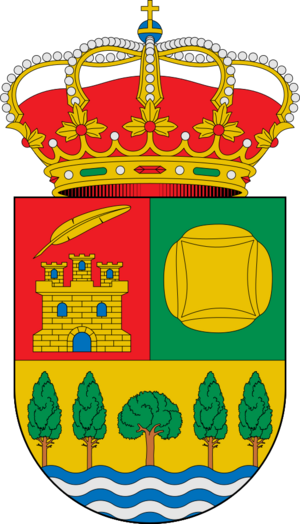Bread of Alfacar facts for kids
Bread of Alfacar is a special type of bread from Alfacar, a town in Spain. It has a special seal called a Protected Geographical Indication (PGI). This seal means the bread is made in a traditional way in a specific area.
The bread is made with wheat flour, sourdough, yeast, salt, and water from the Alfacar spring. Bakers use the same dough to make different shapes of bread. These shapes include bollo, rosco, rosca, and hogaza. The inside of the bread is soft and creamy white. It has many small, uneven holes. This bread tastes great with local dishes like fried mushrooms or goat stew.
The towns allowed to make this bread are Alfacar and Víznar. Alfacar has about 5,500 people, and Víznar has less than 1,000. Both towns are at the foot of the La Alfaguara Mountain Range. They are about 5 kilometers north of the city of Granada. Alfacar and Víznar have always supplied bread to Granada city.
Contents
History of Alfacar Bread
Early History
The bread-making business in Alfacar and Víznar grew a lot after the Reconquista. This was when the Catholic Monarchs took back the Nasrid Kingdom from the Muslims in the late 1400s. After the war, more Christian people moved to the area.
The war had made it hard to get food. So, new rules were made to make sure people had enough to eat. This included making sure the city of Granada had enough bread. This helped the bread industry in Alfacar and Víznar become very important.
20th Century Growth
By 1950, Alfacar and Víznar were the main bread suppliers for the Granada area. A geographer named Bosque Laurel noted this. At that time, Alfacar had 9 ovens and 41 bakers. They worked at night to make bread for Granada and during the day for local people. Around 1950, about 7,000 kilograms of Alfacar Bread were sold daily in Granada. People really liked its excellent quality.
In 1973, bakers from Alfacar and Víznar started a cooperative group. They worked together to make and sell "Pan de Alfacar." They opened 15 shops in Granada city. Many of these shops are still open today. Even back then, signs in these shops proudly showed the name "Pan de Alfacar."
In 1991, a writer named José Carlos Capel wrote about the roscos de Alfacar. He mentioned them in his book about bread. The rosco is one of the special shapes of Alfacar bread. It has its own recipe and way of being made. It is a true example of Spanish cuisine.
Today's Recognition
The bread-making business in Alfacar and Víznar has grown and become strong because "Pan de Alfacar" is so well-known. People know it for its special qualities. A study in Granada province showed how famous this bread is.
In 2013, the Alfacar Bakers Guild asked for their bread to be recognized as a Protected Geographical Indication. This is a special quality label from the European Union. "Pan de Alfacar" became one of only 16 bakery products in Spain to have this important seal.
What Makes Alfacar Bread Special?
To be sold as "Bread of Alfacar," the bread must follow strict rules. These rules cover the ingredients, how it's made, and even baking times and temperatures.
The flour used is wheat flour with a specific strength. The water comes from a spring in the Sierra de Alfaguara mountains. This water supplies Alfacar and Víznar. It is known for being a bit hard and having a certain pH level. To make the dough rise, bakers use leftover dough from the day before, called "mother dough." They might also add fresh yeast.
These special ingredients and methods create a unique bread. The inside, called the crumb, is soft and creamy. It has many uneven holes. The crust is thick, shiny, and golden. It is not covered in flour.
The ovens that make Alfacar bread also have to meet certain rules. They must be approved by a special group that checks their quality.
Types of Alfacar Bread
Alfacar bread comes in different shapes:
- Bollo: This bread is long with pointy ends, sometimes called "tits." It has one long line down the middle. It comes in 80, 125, and 250 gram sizes.
- Rosco: These are 250 gram pieces shaped like an oval ring. They have a flattened, tube-like shape and one long rib.
- Rosca: These are 500 gram pieces that are circular rings. They have a round, tube-like shape. You can spot them by their special hand-joined point called "mother-in-law."
- Hogaza: These are round loaves that are slightly domed on top. They can weigh 250 grams, 500 grams, or 1 kilogram. They have a special mark on top, like a grid inside a square made of four cuts.
Alfacar Bread in Books
In 2008, a book called "El pan de Alfacar: bakeries and traditional ovens" was published. It tells the history of this bread from the 1500s to the 2000s. Many old books and studies also show how important the Alfacar bread business was. They talk about how it was sold in Granada and nearby areas.
For example, old records from 1571 and 1572 mention the bread after the reconquest of Granada. A dictionary from 1795 also talks about it. In the 1830s, Pascual Madoz wrote that Alfacar had 12 ovens and 17 mills. These mills ground a lot of wheat every day. This meant Alfacar not only made bread for itself but also sent a lot of flour and "Pan de Alfacar" to Granada and the surrounding areas.
See also
 In Spanish: Pan de Alfacar para niños
In Spanish: Pan de Alfacar para niños



